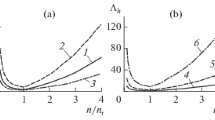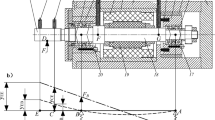Abstract
This paper investigates the friction and wear characteristics of two typical hydrodynamic bearings for hard disk drive (HDD) spindle motors (SPM), i.e., the herringbone groove and multi-taper bearings, during start-up and shut-down transient operation. The friction characteristics are calculated by a lubricated friction model which is an extension of Kogut and Etsion’s dry friction model (a modified version of the CEB model), while the wear characteristics are qualitatively evaluated in non-dimensional form by the semi-analytical wear model proposed by Holm–Archard. The average flow Reynolds equation and the pressure-compliance relationship of elastic–plastic roughness contact are used together to consider the combined effects of partial lubrication and asperity contact occurring during start-up and shut-down. Then, the friction and wear characteristics of the herringbone groove and multi-taper bearings are calculated and compared under the condition of HDD application.












Similar content being viewed by others
Abbreviations
- a c :
-
ratio of real contact area to nominal contact area
- B :
-
length of bearing, \({\bar{B} = B/2R}\)
- d :
-
distance between mean planes of asperity heights of two contacting rough surfaces
- E :
-
Young’s modulus
- E 1, E 2 :
-
Young’s moduli of journal and bearing
- E( ):
-
expectancy operation
- e :
-
eccentricity of journal
- e u :
-
eccentricity of mass of journal
- \({\dot{e}}\) :
-
velocity of journal
- F :
-
reactive forces, \({\bar{F} = F/{\left( {p_{s} RB/2} \right)}}\)
- H :
-
h/σ
- H B :
-
Brinell hardness
- h :
-
clearance of bearing, \({\bar{h} = h/h_{0}}\)
- h 0 :
-
nominal clearance of bearing
- h p :
-
depth of groove, \({\bar{h}_{p} = h_{p} /h_{0}}\)
- h T :
-
local clearance
- I p :
-
moment of inertia of journal
- K :
-
hardness coefficient
- k :
-
wear coefficient
- M :
-
frictional torque, \({\bar{M}=M/\left(p_{s}R(B/2)^{2}\right)}\)
- m :
-
mass of journal
- N g :
-
number of grooves/tapers
- N s :
-
number of asperities per unit area
- P l :
-
power consumption, \({\bar{P}_{l} = l{\left( {p_{s} R{\left( {B/2} \right)}^{2} \dot{\Theta }_{{Z0}} } \right)}}\)
- p c :
-
contact pressure
- p h :
-
hydrodynamic pressure
- p s :
-
nominal pressure, p s = 0.101MPa
- R :
-
radius of journal
- R s :
-
average radius of asperity summits
- T :
-
driving torque, \({\bar{T} = T/{\left( {p_{s} R{\left( {B/2} \right)}^{2} } \right)} }\)
- t :
-
time, \({\bar{t} = t/t_{\rm c}}\)
- t b :
-
thickness of adsorbed surface film
- t c :
-
time constant, \({t_{\rm c} = 2\pi /\dot{\Theta }_{{Z0}}}\)
- V w :
-
wear volume, \({\bar{V}_{w} = V_{w} /{\left( {h_{0} RB/2} \right)} }\)
- W :
-
applied force, \({\bar{W} = W/{\left( {p_{s} RB/2} \right)} }\)
- X :
-
coordinate axis
- Y :
-
coordinate axis
- Y S :
-
yield strength of material, Y S = H B /2.8
- Z :
-
coordinate axis, \({\bar{Z} = Z/{\left( {B/2} \right)} }\)
- β:
-
angle of herringbone groove
- γ:
-
positional angle of bearing
- γP :
-
Peklenik number
- δ:
-
height of roughness
- δ b :
-
termination criterion for equilibrium equations
- ɛ:
-
eccentricity ratio, ɛ = e/h 0
- η:
-
viscosity of lubricant
- Θ Z :
-
rotational angle of journal
- \({\dot{\Theta }_{Z}}\) :
-
angular velocity of journal, \({\bar{\dot{\Theta }}_{Z} = \dot{\Theta }_{Z} t_{\rm c}}\)
- \({\dot{\Theta }_{{Z0}}}\) :
-
nominal angular velocity of journal
- \({\dot{\Theta }_{{Z,{\rm startup}},} \dot{\Theta }_{{Z,{\rm shutdown}}} }\) :
-
termination criteria for startup and shutdown computation
- θ:
-
θ l + θ p
- θ l :
-
half of land width
- θ p :
-
half of groove width, \({\bar{\theta }_{p} = \theta_{p} /\theta }\)
- μ:
-
friction coefficient
- ν:
-
Poisson’s ratio
- ν1, ν2 :
-
Poisson’s ratios of journal and bearing
- σ:
-
combined standard deviation of rough surfaces
- σ s :
-
combined standard deviation of asperity heights
- τc :
-
shear stress of rough contact
- τh :
-
shear stress of hydrodynamic lubrication
- Φ:
-
angular coordinate
- ϕ pΦ, ϕ pZ :
-
pressure flow factor
- ϕ sΦ :
-
shear flow factor
- χ0 :
-
initial phase angle of journal
- ψ:
-
composite probability density function (PDF) of rough surface
- ψ s :
-
composite PDF of asperity height
- ω:
-
interference, ω = δ− d
- ω M :
-
critical interference for contact via adsorbed surface film
- ω p :
-
critical interference of elastic deformation, \({\bar{\omega }_{p} = \omega _{p} /\sigma _{s} }\)
- c :
-
adhesion induced by adhesive contact
- h :
-
adsorption induced by contact via adsorbed surface film
- X,Y,Z :
-
along X, Y axis, around Z axis
References
Archard JF (1953) Contact and rubbing of flat surfaces. J Appl Phys 24:981–989
Burwell JT, Strang CD (1952) On the empirical law of adhesive wear. J Appl Phys 23:18–28
Chang WR, Etsion I, Bogy DB (1988) Static friction coefficient model for metallic rough surfaces. ASME J Tribol 110:57–63
Feng M, Ono K, Mimura K (2003) Mixed EHL analysis of the variable torque slipping clutch with skewed rollers. ASME J Tribol 125:756–769
Feng M, Ono K, Mimura K (2003) The FEM analysis of dry contact in the variable torque slipping clutch with skewed rollers by using weighted simplex and BFGS methods. ASME J Mech Des 125:186–199
Holm R (1946) Electric contacts. Almqvist and Wiksells, Stockholm
Johnston G, Wayte R, Spikes HA (1991) The measurement and study of very thin lubricant films in concentrated contacts. Tribol Trans 34:187–194
Kogut L, Etsion I (2003) A semi-analytical solution for the sliding inception of a spherical contact. ASME J Tribol 125:499–506
Kogut L, Etsion I (2004) A static friction model for elastic–plastic contacting roughness surfaces. ASME J Tribol 126:34–40
Ono K, Zhu J, Cui C (1998) A comparison study on the characteristics of five types of hydrodynamic oil bearings for hard disk spindles. Adv Inform Storage Syst 9:33–46
Patir N, Cheng HS (1978) An average flow model for determining effects of three dimensional roughness on partial hydrodynamic lubrication. ASME J Lubric Technol 100:12–17
Patir N, Cheng HS (1979) Application of average flow model to lubrication between rough sliding surfaces. ASME J Lubric Technol 101:220–230
Rowe CN (1966) Some aspects of the heat of adsorption in the function of a boundary lubricant. ASLE Trans 9:100–111
Stolarski TA (1979) Adhesive wear of lubricated contacts. Tribol Int 12:169–179
Wu S, Cheng HS (1991) A sliding wear model for partial-EHL contacts. ASME J Tribol 113:134–141
Yang Z, Chung Y, Cheng HS (1996) Lubricant effects in the transition from boundary to microelastohydrodynamic lubrication. Tribol Trans 39:974–978
Zou Q, Huang P, Wen S (1996) Abrasive wear model for lubricated sliding contacts. Wear 196:72–76
Acknowledgments
The authors would like to thank Nidec Corporation for permission to publish these results. The authors are also indebted to Messrs. D. Kikuchi, S. Kitahira and M. Takada for their assistance with the experimental setup and testing.
Author information
Authors and Affiliations
Corresponding author
Rights and permissions
About this article
Cite this article
Feng, M., Kenjo, T. Friction and wear of spindle motor hydrodynamic bearings for information storage systems during startup and shutdown. Microsyst Technol 13, 987–997 (2007). https://doi.org/10.1007/s00542-006-0305-x
Received:
Accepted:
Published:
Issue Date:
DOI: https://doi.org/10.1007/s00542-006-0305-x




